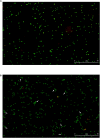Induction of Viable but Nonculturable Escherichia coli O157:H7 by Low Temperature and Its Resuscitation
- PMID: 30555428
- PMCID: PMC6282054
- DOI: 10.3389/fmicb.2018.02728
Induction of Viable but Nonculturable Escherichia coli O157:H7 by Low Temperature and Its Resuscitation
Abstract
Viable but non-culturable (VBNC) cells are alive bacteria cells, but lose their culturability in conventional culture media, usually escape detection by the plate count method and pose a serious threat to food safety and public health. Therefore, it is urgent to study the VBNC status, and to provide theoretical basis and scientific basis for food processing and safety control caused by pathogenic microorganisms. In this study, Escherichia coli O157:H7 was induced to the VBNC state at two different temperatures (-20°C and 4°C) and its resuscitation and morphological changes under different nutritional conditions were studied. The initial inoculum of 2.1 × 107 CFU/mL E. coli O157:H7 cells were induced into the VBNC state in normal saline, distilled water, LB broth at -20 °C after 176, 160, 80 days, respectively. The results showed that E. coli O157:H7 reserved at -20°C, and LB culture medium were easier to enter VBNC state than others conditions, the cells still had metabolic activity and the cell morphology changed from the typical rod shape to short rod and the cell size decreased. The resuscitate ways including the direct warming resuscitation, gradual warming resuscitation, adding chemical substance resuscitation, and adding nutrients resuscitation were studied. The results showed that the optimal conditions of 5% Tween 80 and 3% Tween 80 acculated the resuscitation of E. coli O157:H7 VBNC state cells induced by low temperature LB medium and low temperature saline. E. coli O157:H7 VBNC state failed from resuscitation when incubating in LB broth, respectively using direct warming and adding nutrients substance. This study provides new insights into induction and resuscitation of VBNC E. coli O157:H7 and offers an approach for investigating the formation mechanism of VBNC foodborne pathogens in food safety.
Keywords: Escherichia coli O157:H7; food safety; induction; low temperature; resuscitation; viable but non-culturable state.
Figures








Similar articles
-
Detection and Verification of the Viable but Nonculturable (VBNC) State of Escherichia coli O157:H7 and Listeria monocytogenes Using Flow Cytometry and Standard Plating.J Food Sci. 2018 Jul;83(7):1913-1920. doi: 10.1111/1750-3841.14203. Epub 2018 Jun 15. J Food Sci. 2018. PMID: 29905952
-
Formation and Control of the Viable but Non-culturable State of Foodborne Pathogen Escherichia coli O157:H7.Front Microbiol. 2020 Jun 16;11:1202. doi: 10.3389/fmicb.2020.01202. eCollection 2020. Front Microbiol. 2020. PMID: 32612584 Free PMC article.
-
A hidden risk: Survival and resuscitation of Escherichia coli O157:H7 in the viable but nonculturable state after boiling or microwaving.Water Res. 2020 Sep 15;183:116102. doi: 10.1016/j.watres.2020.116102. Epub 2020 Jun 26. Water Res. 2020. PMID: 32745672
-
Significance of Viable but Nonculturable Escherichia coli: Induction, Detection, and Control.J Microbiol Biotechnol. 2017 Mar 28;27(3):417-428. doi: 10.4014/jmb.1609.09063. J Microbiol Biotechnol. 2017. PMID: 27974738 Review.
-
Induction, detection, formation, and resuscitation of viable but non-culturable state microorganisms.Compr Rev Food Sci Food Saf. 2020 Jan;19(1):149-183. doi: 10.1111/1541-4337.12513. Epub 2019 Dec 19. Compr Rev Food Sci Food Saf. 2020. PMID: 33319518 Review.
Cited by
-
Multidrug-Resistant Biofilms (MDR): Main Mechanisms of Tolerance and Resistance in the Food Supply Chain.Pathogens. 2022 Nov 24;11(12):1416. doi: 10.3390/pathogens11121416. Pathogens. 2022. PMID: 36558750 Free PMC article. Review.
-
Formic acid, an organic acid food preservative, induces viable-but-non-culturable state, and triggers new Antimicrobial Resistance traits in Acinetobacter baumannii and Klebsiella pneumoniae.Front Microbiol. 2022 Nov 24;13:966207. doi: 10.3389/fmicb.2022.966207. eCollection 2022. Front Microbiol. 2022. PMID: 36504816 Free PMC article.
-
Metabolomic Differences between Viable but Nonculturable and Recovered Lacticaseibacillus paracasei Zhang.Foods. 2023 Sep 18;12(18):3472. doi: 10.3390/foods12183472. Foods. 2023. PMID: 37761181 Free PMC article.
-
Induction and Resuscitation of Viable but Nonculturable Corynebacterium diphtheriae.Microorganisms. 2021 Apr 26;9(5):927. doi: 10.3390/microorganisms9050927. Microorganisms. 2021. PMID: 33925877 Free PMC article.
-
Synergistic Action of Mild Heat and Essential Oil Treatments on Culturability and Viability of Escherichia coli ATCC 25922 Tested In Vitro and in Fruit Juice.Foods. 2022 May 30;11(11):1615. doi: 10.3390/foods11111615. Foods. 2022. PMID: 35681366 Free PMC article.
References
LinkOut - more resources
Full Text Sources
Molecular Biology Databases

